Tuesday, 25 April 2017
| Room 312 |
16:15 - 18:15 |
Moderators: Tony Stoecker, An Vu |
Slack Channel: #s_fmri
Session Number: O78
16:15
 |
0580.
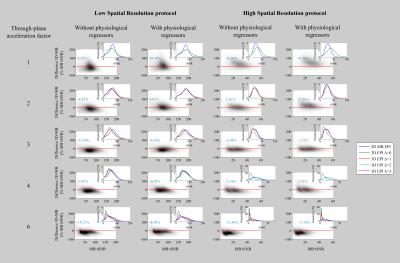 |
3D-EPI-CAIPI and 2D-Multiband-EPI: which is best for fMRI at 3T? 
Nadège Corbin, Oliver Josephs, Martina Callaghan
2D-MB-EPI and 3D-EPI-CAIPI acquisition schemes can be used to increase spatiotemporal resolution in fMRI. This study examined which approach is optimal at 3T, over a range of temporal and spatial resolutions, while maintaining extended brain coverage. 10 protocols were tested in vivo for each sequence spanning low and high spatial resolution and a range of through-plane acceleration factors. 3D-EPI-CAIPI outperforms 2D-MB-EPI at lower temporal resolutions, as long as physiological effects are corrected and the maximal CAIPIRINHA shift is used. The benefit is greater at higher spatial resolution. However, as the temporal resolution increases, by increasing the through-plane acceleration, 2D-MB-EPI becomes preferable.
|
16:27
|
0581.
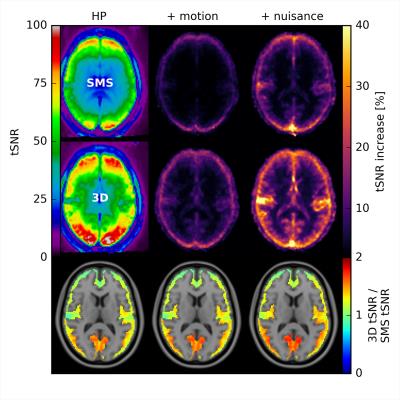 |
The effect of motion and nuisance regression on resting-state fMRI using highly accelerated SMS- or 3D-EPI 
Rüdiger Stirnberg, Willem Huijbers, Monique Breteler, Tony Stöcker
We compare the effects of motion and nuisance regression on highly accelerated resting-state fMRI of 10 subjects scanned at 3T using state-of-the-art simultaneous multi-slice EPI and segmented 3D-EPI with controlled aliasing. While both TR-matched protocols are per design fast enough to separate the cardiac frequency peak from BOLD signal, gray matter signal-to-noise ratio with the 3D-EPI protocol improves almost twice as much as compared to the SMS-EPI protocol. Template based rotation functional connectivity analysis on average shows greater statistical loadings for several known networks when using cleaned 3D-EPI data than when using cleaned SMS-EPI data.
|
16:39
 |
0582.
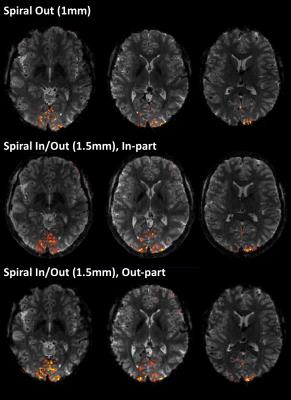 |
High-resolution Spiral fMRI at 7T 
Lars Kasper, Maria Engel, Christoph Barmet, Thomas Schmid, Klaas Stephan, Klaas Pruessmann
High-resolution spiral fMRI acquisition at 7 Tesla is shown with excellent image quality and geometric veracity. Both, high-resolution spiral-out (1mm isotropic) and multi-echo spiral-in/out readouts (1.5mm) are acquired in a visual paradigm, performed by 2 subjects. The datasets are analyzed by SPM and activation patterns are shown overlaid over the actual fMRI datasets of almost structural imaging quality.
|
16:51
|
0583.
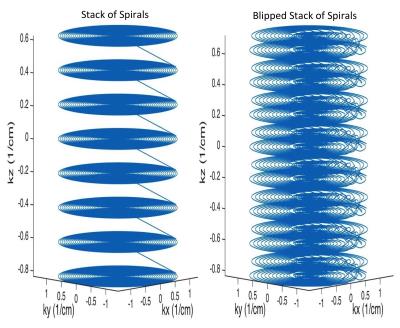 |
Blipped Stack of Spirals for Fast Volumetric Functional MRI 
V. Andrew Stenger, Christoph Rettenmeier
This work presents a volumetric acquisition technique for fast fMRI using spirals and parallel imaging. Gradient blips were added along the readout of a stack of spirals sequence to produce a blipped stack of spirals for a more efficient sampling scheme. Phantom images and human fMRI experiments show that the method is capable of providing approximately a factor of two speed increase compared to a standard volumetric stack of spirals.
|
17:03
|
0584.
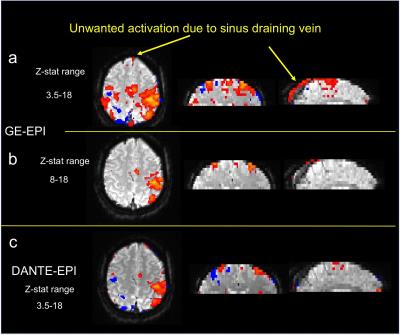 |
Localization of Neural Activity Using DANTE-Prepared Multi-slice EPI (DANTE-EPI) for BOLD Detection 
Linqing Li, Christine Law, Karla Miller, Peter Jezzard
To assess whether DANTE-EPI (Delay Alternating with Nutation for Tailored Excitation) sequence for moving blood suppressed fMRI images can effectively reduce inflow effects and, physiological noise originating from intravascular blood signal, and spurious (false positive) functional activation resulting from draining vein effects. Results were compared with images from conventional gradient echo planar imaging (GE-EPI).
|
17:15
|
0585.
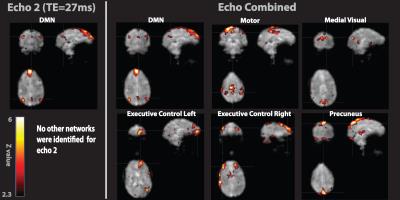 |
Silent, Multi-Echo T2* Looping Star fMRI 
Ana Beatriz Solana, Anne Menini, Brice Fernandez, Florian Wiesinger
In this work, we propose a novel method for quiet, 3D, T2* BOLD fMRI in form of multi-echo Looping Star. Its inaudible scanning offers unique potential for pediatric imaging, imaging auditory or speech paradigms, as well as for resting-state studies. In comparison to standard Gradient-Echo EPI, Looping Star demonstrated better tSNR and lower temporal drift. Motor activation and identification of resting state networks are demonstrated for single and combined echo processing.
|
17:27
 |
0586.
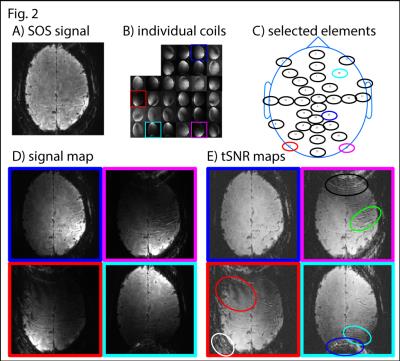 |
Simple approach to improve time series fMRI stability: STAbility-weighted Rf-coil Combination (STARC) 
Laurentius Huber, David Jangraw, Sean Marrett, Peter Bandettini
Advanced EPI -especially at high resolutions- is often limited by signal instabilities arising from a variety of unwanted artifacts. These include: GRAPPA ghosts interference, Nyquist ghosts, phase offset interference patterns, and fat rings. The sources of these artifacts are all somewhat locally confined and are often differently pronounced in different elements of multi coil arrays. Here we propose a simple approach of STAbility-weighted Rf-coil Combination (STARC) that reduces the likelihood of those artifacts. It increases tSNR and fMRI sensitivity up to 50% without a loss in quantifiability, without loss in temporal resolution, and without loss in spatial resolution.
|
17:39
|
0587.
 |
Multi-channel fMRI Denoising Based on Tensor Decomposition 
Jun Cao, Yilong Liu, Mengye Lyu, Grantham Pang, Ed Wu
Conventional fMRI analysis applies spatial Gaussian smoothing to increase SNR, which does not fully utilize multichannel information in fMRI, and often lead to smearing of fMRI images. In this work, we proposed to denoise multichannel fMRI data based on tensor decomposition. Specifically, fMRI data are treated as a 3rd-order tensor, and Canonical Polyadic Decomposition (CPD) is used to approximate fMRI data with sum of limited number of rank-1 terms. Results show its effectiveness in denoising block-design task-related fMRI data, leading to increased temporal SNR and sensitivity of activation detection without sacrificing spatial resolution.
|
17:51
|
0588.
 |
Dual region-selective spiral pTX excitation for digit mapping fMRI in motor cortex and cerebellum 
Benedikt A Poser, Amanda L Kaas, Christopher J Wiggins, Kâmil Uludag, Desmond H Y Tse
We demonstrate the use of 2D-selective excitation with parallel transmission to (a) simultaneously perform BOLD fMRI on two apart brain regions, and (b) benefit from high acceleration factors achievable with sparse volume excitation. Using 8ch pTX at 7T, we apply spatially selective pulses to excite the primary motor and sensory cortices, as well as cerebellum. tSNR measures confirm superior performance compared to whole-brain excitation at the same TR. A finger tapping task is used to elicit digit-specific activation, which is observed in primary cortex and cerebellum.
|
18:03
|
0589.
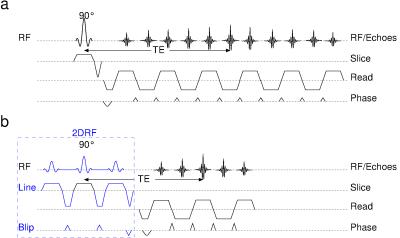 |
T2*-Weighted Echo-Planar Imaging of the Spinal Cord: Full vs. Inner Fields-of-View 
Jürgen Finsterbusch
BOLD-based fMRI of the spinal cord is challenging because the high resolution required and the field inhomogeneities present promote geometric distortions in echo-planar imaging and T2*-related signal losses which both hamper the image quality and the SNR. With inner-field-of-view imaging techniques, e.g. based on spatially 2D-selective RF excitations, the acquisition can be focussed to the spinal cord which allows to minimize geometric distortions. Furthermore, shorter echo time can be achieved resulting in a significantly increased SNR that may make fMRI feasible throughout the spinal cord.
|
|











